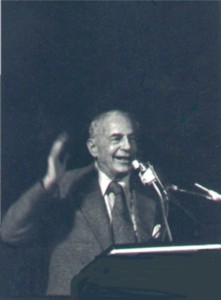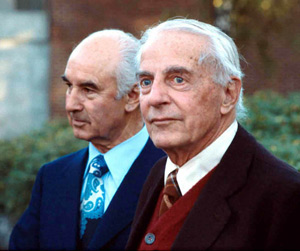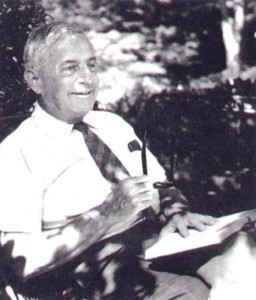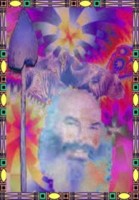Mushroom Pioneers
Chapter 4. The Rediscovery of Entheogenic Mushrooms
Wasson's First Voyage
 |
Fig. 5. R. Gordon Wasson 1st International Conference on Hallucinogenic Mushrooms, 1976 Photo: Linda Dear |
R. Gordon Wasson's interest in mushrooms began during his honeymoon in the Catskill mountains. Wasson and his Russian-born wife, pediatrician Valentina Pavlovna Wasson were hiking one day on a forest-trail when suddenly she espied a cluster of mushrooms which she recognized as being similar to ones she used to gather from the forest for dinner in her native Russia. Overcome with great joy, Valentina picked as many mushrooms as she could carry and that evening she prepared and served them with their evening dinner. Of course, R. Gordon Wasson declined to eat any of the "nasty toadstools" his new wife had gathered from the forest and told her he did not want to awake a widower, thinking that all mushrooms were poisonous (Wasson, 1957a; Wasson & Wasson, 1957). It was for this reason that Gordon Wasson soon began to wonder why Slavic peoples love the mushrooms while some western Europeans abhorred them. Thus began the age of ethnomycology.
Wasson, who worked as a journalist, soon became interested in banking and in 1928 began working as an investment-banker for Morgan Guaranty Trust. By the early 1950's, Wasson had become a vice-president of J. P. Morgan & Company.
At that time, Wasson received an important letter from Eunice V. Pike, a missionary from the Wycliff Bible Translators. Pike had been living for many years among the Mazatec Indians in the southern Mexican State of Oaxaca. She wrote to Wasson informing him that there were Indian medicine-men and medicine-women who employed certain mushrooms in curative ceremonies. Pike informed Wasson that the use of these mushrooms probably originated prior to the conquest (see Pike & Cowan, 1959; Pike, 1960).
Wasson also received a letter from the noted Greek historian and scholar Robert Graves. Graves informed Wasson of two research articles written by Harvard ethnobotanist Richard Evans Schultes (see Davis, 1997), concerning a mysterious mushroom known to the ancient Aztec people as teonanácatl.
However, Schultes' papers concerning the use of these mushrooms by the Aztecs at the time of the Spanish conquest had generated little interest within the scientific community (Schultes, 1939, 1940). In fact, the question of whether or not the mushrooms ever existed had been raised.
Wasson received another letter from his Italian printer which included a sketch of a Guatemalan mushroom-stone carving some 2000 years old. The drawing represented a sculpture of a man with a mushroom projecting from his head. The sculpture had been discovered somewhere deep in the jungles of Guatemala.
These startling new revelations piqued Wasson's interest immensely, so he then contacted Schultes (Pers. Comm. 1988): "One day I was home from the Amazon. Wasson phoned me for references to México." Schultes then went on to say "I sent him to Reko who was very helpful to him and who introduced him to Weitlaner. Thus Reko still had his contribution towards the study of the mushrooms." (Blas Pablo Reko, along with Schultes, had collected specimens of the alleged sacred fungi for herbarium deposit and Roberto Weitlaner was the first westerner to observe a sacred mushroom ceremony during the late 1930's).
In 1953, Wasson and his wife traveled to México. After arriving in the Mazatec country and inquiring about the sacred mushrooms they finally succeeded in attending an all night velada (as the ceremony is called by the Mazatec shamans or curanderos, who officiate and perform them). This first ceremony was conducted under the guidance of a Mazatec shaman named Don Aurelio Carreras. At the first ceremony, Wasson observed the procedures and took notes of what transpired, but was not allowed to join in nor partake of the mushrooms, However, he was very ecstatic over the performance, and felt no regret for not having been able to fully participate.
Wasson led two more exploratory excursions into México during the following two years. On his third trip to Oaxaca and his second to Huautla de Jiménez, Wasson and his photographer-friend Allan Richardson themselves in the tiny village of Huautla de Jiménez perched high in the Sierra Mazateca of Oaxaca. On the night of 29-30 June 1955, Wasson and Richardson became the first outsiders to partake of the sacred mushrooms.
After Wasson and Richardson had found lodging, they set out on separate searches, asking everyone they encountered for help in their mushroom hunt. After several hours of fruitless questioning of the natives, Wasson decided to ask a local government official to discuss the secrets of the mushrooms with him. He went to the local municipio (city hall), although he was aware that many government officials were dishonest and corrupt, especially when it came to matters involving foreigners. But Wasson felt he hadn't much to lose by approaching the official.
Wasson met a man working in the office of the mayor who was the town's sindico. The sindico is the number two man in a municipio, and since his boss was away on business, he was the acting mayor.. His name was Cayetano García Mendoza. After exchanging introductions and greetings with García, Wasson in his polite and humble manner discussed with him general topics such as the weather, maize-crop prices, problems with the drinking water, the current prices of coffee, etc. It wasn't long before Wasson found himself leaning over the counter towards Cayetano and whispering the Mazatec name for the mushrooms.
With that Cayetano appeared bewildered and astonished. How could a foreigner have knowledge of such a well kept-secret that very few Mazatec people would mention so casually? But in answer to Wasson's question, Cayetano replied that "nothing could be easier", and then he asked Wasson "to come to my humble abode after four o'clock, when I am finished with my day's work, and I would be ever so glad to help you with your unusual request."
Later that afternoon, Wasson and his friend Richardson arrived at the home where Cayatano resided with his two younger brothers, who were waiting for the strangers to arrive. Emilio and Genero led them down the road to a spot not more than a hundred feet from Cayetano's house, where they found an abundance of mushrooms fruiting out of sugar-cane mulch.
While Richardson began photographing the mushrooms, Wasson picked several and placed them gently into a paste board box which he had brought along for this occasion.
Wasson Meets María Sabina #
In the meantime, while Wasson was picking mushrooms, Cayetano proceeded to the home of his friend, Doña María Sabina, a sabia ('wise one' or 'wise woman'). Cayetano found Doña María alone in her home and related to her the events that had transpired earlier that day. He told her "that some blond men have traveled from afar in search of a sabia, and he quietly mentioned to her that the blond stranger had spoken to him in a soft quiet whisper, asking him in a discreet way, that he was seeking 'nti-xi-tjo (Estrada, 1976). Although Cayetano was somewhat startled by the question asked of him, he confirmed his feeling of the stranger's request, explaining to Doña María that the blond stranger "knew of what it was that he was talking about." Cayetano felt that Wasson was definitely sincere in learning the secrets of 'nti-xi-tjo. Apparently Wasson's discretion with Cayetano had confirmed his sincerity in seeking knowledge about the mushrooms and their use, which had convinced Cayetano to talk with Doña María, so to convey to her the message from the blond strangers from a far-away land.Cayetano then explained to Doña María that he told the visitors "I know a true wise woman." Cayetano asked Doña María if he could bring the strangers to her home so that she might teach them the true knowledge of the mushrooms. Doña María replied, "if you want to, I can't say no".
Years later, María Sabina stated that she felt compelled to accept Wasson's request because of Cayetano's official position, and she assumed Cayetano's visit to her humble dwelling that hot summer day was official business.
Many years later, Wasson wondered if María Sabina would have shared her knowledge of the mushrooms with him had Cayetano not intervened as he did. In 1971, Wasson read an interview with María Sabina which appeared in the European magazine L'Europe, published in Milan. It reported that when Cayetano had requested her aid in helping the foreigners, she did so because she felt she had no choice. But she also declared that when she was asked to meet them [Wasson and Richardson] that she "should have said no."
By late afternoon, Wasson, Richardson, and their friends Emilio and Genero, had finished picking the mushrooms and returned to Cayetano's home just as he was returning from seeing María Sabina. It should be noted that a few days later, Wasson offered to pay Cayetano for the fine hospitality and services they had provided Wasson and Richardson, but Cayetano and his wife refused. They informed Wasson that they had been happy to help, and "didn't do so for money.".
Cayetano requested that Emilio accompany them to María Sabina's home to act as interpreter. Once there, Wasson opened his paste-board box and exposed the mushrooms he had just picked. Doña María cried out in joy upon seeing the honguitos which she so loved and adored. She held them in her small hands, caressing them while talking to them in her own language. Arrangements were soon made for a velada later that evening.
On the evening of June 29, 1955, Wasson and Richardson became the first white people to consume the sacred mushrooms of the ancient Mazatec people, in a ceremony held under the supervision of curandera Doña María Sabina, who performed for them a velada or vigil at the home of her friend Cayetano García.
Wasson later wrote, "we all ate our mushrooms facing the wall where the small altar table stood. We ate them in silence, except for Cayetano's father, don Emilio, who was consulting the mushrooms about his infected left forearm. He would jerk his head violently with each mushroom that he swallowed, and utter a smacking noise, as though in acknowledgment of their divine potency. I was seated in the corner of the room on the left of the altar. The señora asked me to move because the word would come down there…"
"I joined Allan immediately behind the señora, we took about a half hour to eat our six pairs of mushrooms. By eleven o'clock we had finished our respective portions, the señora crossing herself with the last swallow.…At about 11:20 Allan leaned from his chair and whispered to me that he was having a chill. We wrapped him in a blanket.. A little later he leaned over again and said, `Gordon, I am beginning to see things,' to which I gave him the comforting reply that I was too."
"The patterns grew into architectural structures, with colonnades and architraves, patios of regal splendor, the stonework all in brilliant colors--gold and onyx and ebony--all harmoniously and ingeniously contrived, in richest magnificence extending beyond the reach of sight. These architectural visions seemed oriental, though at every stage I pointed out to myself that they could not be identified with any specific oriental country..."
"At one point in the faint moonlight the bouquet on the table assumed the dimensions and shape of an imperial conveyance, a triumphal car, drawn by zoological creatures conceivable only in an imaginary mythology, bearing a woman clothed in regal splendor. The visions came in endless succession, each growing out of the preceding ones. We had the sensation that the walls of our humble house had vanished, that our untrammeled souls were floating in the empyrean, stroked by divine breeze, possessed of a divine mobility that would transport anywhere on the wings of a thought. Only when by an act of conscious effort I touched the wall of Cayetano's house would I be brought back to the confines of the room where we all were, and this touch with reality seemed to be what precipitated nausea in me."
 |
Fig. 73. A. Hofmann and R. Gordon Wasson Photo: Jeremy Bigwood |
Doña María referred to Wasson as "Basson" and she allowed the taking of photographs by Richardson on the condition that Wasson would not profane her by allowing other people access to the photographs taken during the ceremony. She requested that Wasson only share them with his closest and dearest friends and that no others should see them. Eventually their publication in Life magazine made María Sabina known to the world. Although this event brought thousands of people into Oaxaca in search of these entheogenic fungi, María Sabina never expressed any resentment toward Wasson as a result.
On the night of July 5, 1955, Wasson's wife Valentina and their 19 year-old daughter Masha (in his 1980 book, The Wondrous Mushroom: Mycolatry in Mesoamerica, Wasson mistakenly reported that Masha was then only 13 years old) became the first westerners to consume entheogenic mushrooms outside of a ritual setting. This would appear to be the first reported incident involving non-traditional use of psychoactive mushrooms (Wasson,v., 1958).
Six weeks later, having returned to New York, Wasson again felt compelled to ingest the mushrooms from México, to ascertain whether dried specimens he had brought back were still active. This was Wasson's third experience with the sacred mushrooms.
Wasson believed there was a link between the mushroom effigies and the use of entheogenic mushrooms in Mesoamerica. Once during an excursion to the village of Juxtlahuaca, México, Wasson photographed a young Mexican girl grinding mushrooms on a matate or grinding stone. The mano she used to grind the mushrooms and her position while doing so, was similar to the posture and form represented on one of the mushroom-stones unearthed in Guatemala (Furst, 1986).
Studies by Villacorta & Villacorta (1927), Johnson (1938), Schultes (1939, 1940), Singer (1949), Wasson & Wasson (1957), Unsigned (1961b), de Borhegy (1962), Lowy (1971, 1972), Ott (1976), Mayer (1977), Weil (1977), Wasson (1980), and others who followed the Wassons brought attention to ancient frescoes, paintings, illustrations and gold-work depicting sacred mushrooms (Schultes and Bright, 1979). The mushroom stones and other art works, including depiction's of mushroom motifs in paintings and sculptures gave ample proof that the entheogenic mushrooms had an important role in the development of spirituality in pre-Colombian cultures.
It is conceivable that some 3000 years ago in Mesoamerica, a sophisticated form of shamanism had flourished and prospered, revolving around the ritual use of entheogenic mushrooms and other visionary inebrients as major foci in the development of Mesoamerican cultures.
Wasson led a total of 10 field-trips into the wilds of Mesoamerica (1953-1962), gathering mushrooms and information on their use in their rituals by the various cultures who used them. Wasson sought the collaboration of many eminent scholars to assist him in these investigations. Specialists who assisted Wasson included: Roger Heim, Gastón Guzmán, Roberto Weitlaner and his daughter Irmagard Weitlaner Johnson, Guy Stresser-Peán, C. Cook de Leonard, W.S. Miller, Searle Hoogshagen, B. Upton and Albert Hofmann who was director of Natural Products at Sandoz in Basel and had discovered LSD before isolating psilocybine and psilocine.
CIA Mole James Moore - Spies on Wasson in the Search for Mind-Control Drugs
 |
Fig. 6. R. Gordon Wasson at home Danbury, Conn. |
A scientist from the CIA's "Project ARTICHOKE" had traveled to México in search of a so-called "stupid bush" and other plants which might derange the human mind, politically useful to control enemies minds in war time. Large quantities of morning-glory seeds were sent to CIA laboratories for analysis by CIA scientists searching for compounds useful for extracting confessions, locating stolen or lost objects, perhaps even predicting the future. Visionary mushrooms were of special interest in these investigations. According to documents obtained via the Freedom of Information Act, James Moore was an expert in chemical synthesis who worked for the CIA. In 1956, Moore invited himself into one of Wasson's expeditions to México. He offered Wasson a grant for $2,000 dollars from a CIA- front known as the Geschickter Fund for Medical Research, Inc. In 1955, Wasson had declined to collaborate openly with the CIA.
Moore did not enjoy his single mushroom experience, perhaps due to the fact that he was not who he represented himself to be. Mayhaps this fact got the better of him, and under the influence of the mushrooms he saw himself as he really was. According to Moore, "I had a terrible cold, we damned near starved to death, and I itched all over. There was all this chanting in the dialect. Then they passed the mushrooms around, and we all chewed them. I did feel the hallucinogenic effect, although 'disoriented' would be a better word to describe my reaction."
Moore collected specimens for his CIA-sponsored research and returned to Maryland, where he endeavored to isolate for the CIA the active principle of both the mushrooms and morning glory seeds. Unfortunately for Moore he was unable to find the active ingredients with the fungi and lucky for the world that he didn't find them since they would of most likely been used as tools of mind war under the direction of the CIA.
In spite of the duplicitous antics of the CIA which predictably came to nothing, Wasson and collaborators documented traditional use of the sacred mushrooms in Oaxaca, Mexico and other states. Wasson and Singer found that several species and/or varieties of mushrooms were still employed ceremonially by some dozen Indian tribes belonging to various linguistic groups. Some of the Mexican Indians spoke no Spanish nor possessed a written language. The following indigenous groups used the sacred mushrooms: Mazatecs, Chinantecs, Chatinos, Zapotecs, Mixtecs, Mixes (Mijes), Nahuas and Otomies and possibly also the Tarascans of Michoacán.
Different Oaxacan Indian tribes prefer different species of mushrooms, and the attendant rituals vary somewhat from village to village. Even within a given tribe not all shamans will use precisely the same mushrooms, depending on what species be available at any given time. More than one species may be used perhaps for specific purposes, during a particular curing ritual (Wasson & Wasson, 1957).
The Wassons' discoveries regarding the visionary mushrooms in México became public knowledge in 1957, with the publication of a two-volume book Mushrooms, Russia and History, limited to 512 copies and never reprinted. Some university libraries have copies in rare-book collections.
Simultaneous with publications of Mushrooms, Russia and History were two popular articles in Life magazine (Wasson, 1957a) and This Week magazine (Wasson, V. P., 1958b). These articles by Gordon Wasson and the other by his wife, captured the beginning of the Psychedelic Era. Collectors of the Wassoniana have been known to pay up to $50.00 for a mint-copy of this particular issue of Life.
A third presentation to the world occurred in 1958, when Gordon Wasson and Roger Heim, together with Albert Hofmann and other collaborators, published Les Champignons Hallucinogènes du Mexique, completed by a second volume ten years later, Nouvelles Investigations sur les Champignons Hallucinogènes, both written in French, some [parts of which originally appeared as papers in Comptes Rendus Acad. Sci. and Revue du Mycologie.
R. Gordon Wasson died on Dec 23, 1986, and is survived by an adopted son and daughter.
 |
Image: Andrew Weil Graphic Design by John W. Allen |


